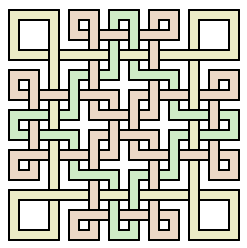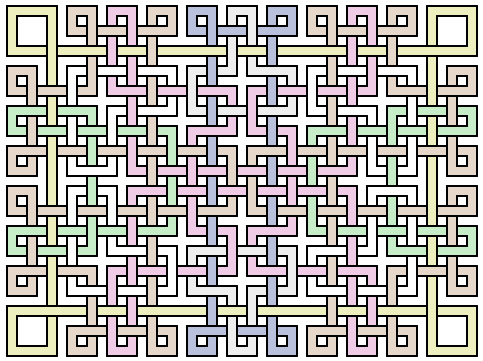Lattice drawings
Created 28 June 2005
When I was a teenager, I loved drawing on graph paper. I invented many rectilinear doodles. One of my specialties was abstract lattices. For example, this is a simple one:

I like this lattice because it nearly fills a square, consists entirely of loops, is symmetric, and has a pleasing denseness in the center without being simply a hatch-work. I recently re-drew it from memory for my son, which got me thinking about the original drawings I did of them. I went and found some of them.
The image above was created on a computer, but 25 years ago I didn’t have that option. So I settled for paper and pencil, but not just any would do: I used 1-mm graph paper and a mechanical pencil. With those simple tools, I made some pretty intricate drawings. I would get into almost a trance-like state creating some of them.
I treasured that graph paper irrationally, to the point that I would try not to waste any of it. So I have pages crowded with drawings on both sides (click to see larger):
My lattice technique was to start with a hatch-work lattice of a certain size, and then poke holes in it to change the shape of the pieces. The esthetics of the exercise were to get the holes so that the weave was dense, but not repetitive.
Here’s one of lattices from that sheet:
This is the same lattice, computer-drawn, with (garish) coloring:

I was always fascinated to see how moving a hole would drastically alter the shapes of the component loops. Certainly, you couldn’t design these things by starting with the loop shapes. How could you get them packed in properly? And working from the holes “magically” made loops that fit together perfectly.
Also on that piece of graph paper was a lattice-of-lattice experiment. It’s the simple lattice shown above, but each strand has been replaced with a trio of strands, which interweave in interesting ways, though the bulk of it ended up being too repetitive. I don’t know if that explains it well:
See also
- Platitude, my program for producing these drawings.
- My blog, where similar topics make appearances now and then.
Colophon
The original artwork was drawn on 1mm graph paper with a mechanical pencil, then scanned at 1200 dpi and scaled and filtered with the Gimp.
The computer-drawn figures here were created with a Python program using aggdraw and Python Imaging Library, then colored with the Gimp.



Comments
Yours are beautifully intricate...
you could make some tricky mazes where (despite being on 2d paper) the "underpasses" of your lattice are considered passable, yet some other cue says that you (your trace) is blocked. y
ou might like plapuzzles, too. google.com/search?q=pla-puzzle images.google.com/images?q=pla-puzzle
(oo. a semi-topical default/obligate avatar.)
You uploaded this the year i was born so i doubt youll see this but i love doing these drawings and didnt realiye there were other people who did it too. stumbled across this by accident. makes me happy to see this is older then me!!
@Nico: things can last a long time on the internet! It makes me happy that you found it after all these years :)
Add a comment: